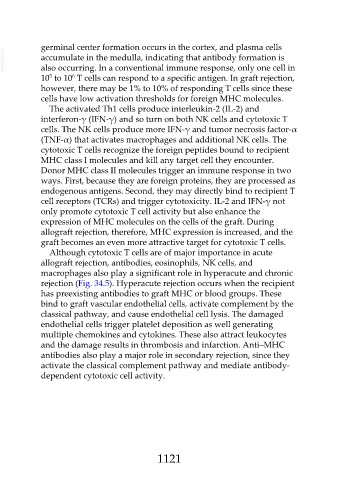Page 1121 - Veterinary Immunology, 10th Edition
P. 1121
germinal center formation occurs in the cortex, and plasma cells
VetBooks.ir accumulate in the medulla, indicating that antibody formation is
also occurring. In a conventional immune response, only one cell in
6
5
10 to 10 T cells can respond to a specific antigen. In graft rejection,
however, there may be 1% to 10% of responding T cells since these
cells have low activation thresholds for foreign MHC molecules.
The activated Th1 cells produce interleukin-2 (IL-2) and
interferon-γ (IFN-γ) and so turn on both NK cells and cytotoxic T
cells. The NK cells produce more IFN-γ and tumor necrosis factor-α
(TNF-α) that activates macrophages and additional NK cells. The
cytotoxic T cells recognize the foreign peptides bound to recipient
MHC class I molecules and kill any target cell they encounter.
Donor MHC class II molecules trigger an immune response in two
ways. First, because they are foreign proteins, they are processed as
endogenous antigens. Second, they may directly bind to recipient T
cell receptors (TCRs) and trigger cytotoxicity. IL-2 and IFN-γ not
only promote cytotoxic T cell activity but also enhance the
expression of MHC molecules on the cells of the graft. During
allograft rejection, therefore, MHC expression is increased, and the
graft becomes an even more attractive target for cytotoxic T cells.
Although cytotoxic T cells are of major importance in acute
allograft rejection, antibodies, eosinophils, NK cells, and
macrophages also play a significant role in hyperacute and chronic
rejection (Fig. 34.5). Hyperacute rejection occurs when the recipient
has preexisting antibodies to graft MHC or blood groups. These
bind to graft vascular endothelial cells, activate complement by the
classical pathway, and cause endothelial cell lysis. The damaged
endothelial cells trigger platelet deposition as well generating
multiple chemokines and cytokines. These also attract leukocytes
and the damage results in thrombosis and infarction. Anti–MHC
antibodies also play a major role in secondary rejection, since they
activate the classical complement pathway and mediate antibody-
dependent cytotoxic cell activity.
1121

